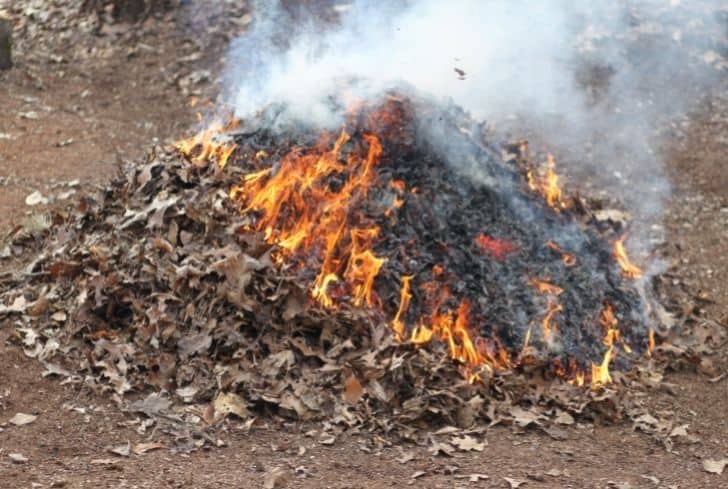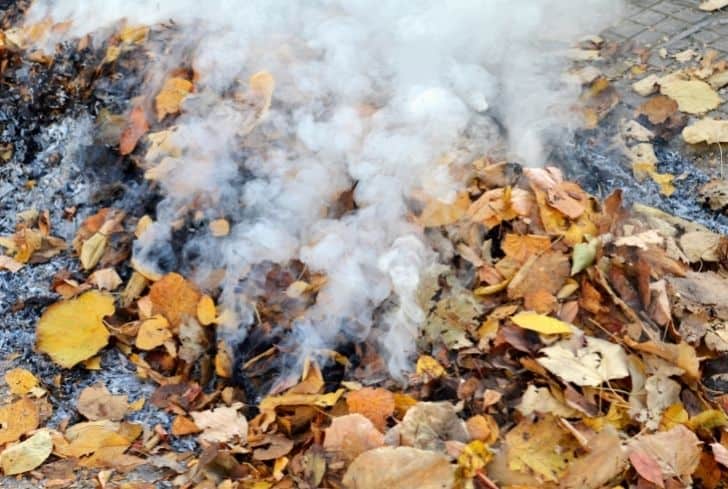Life is such that there is a cycle; birth, maturity, and finally death. This cycle applies to all, regardless of species. This is why trees develop from seeds, mature into big trees and eventually die off, either naturally or taken down by some force. Their leaves also die in the process, giving rise to new ones and the continued growth of the tree.
Given the millions of leaves that die and fall from trees each minute, it has become normal to burn them and be done with them. However, as you might have thought while lighting them up, it might be unhelpful for the environment, even if it saves you a lot. This article, therefore, seeks to understand the risks of burning dry leaves and what else can be done with them.
Does Burning Leaves Hurt the Environment?
Yes, burning leaves, dry or otherwise, hurts and is therefore bad for the environment. Simply put, burning leaves leads to air pollution, health problems and fire hazards. Leaf smoke may also contain hazardous chemicals such as carbon monoxide, which can mix with hemoglobin in the bloodstream and reduce the amount of oxygen in the blood and lungs.
Another noxious chemical commonly present in leaf smoke is benzo (a) pyrene, which has been shown to cause cancer in animals and is believed to be a major factor in lung cancer caused by cigarette smoke.
Additionally, burning leaves will irritate your eyes, nose and throat and could wreak havoc in small children as well as aggravating things for the elderly and people with asthma or other lung or heart diseases.
What’s more, is that burning leaves is a threat to wildlife, the soil, vegetation in addition to being a pollutant to the soil, water and air. Fire kills and injures parts of a plant or the entire plant. This could lead to the wiping out of valuable vegetation, not forgetting the fire could spread quite easily.
If it spreads, it could result in wildfires which are a danger to humans living around them and more so to species that cannot outrun the fires. Wildfires will also disrupt transportation, communications, power and gas services, and water supply. It will also lead to a deterioration of the air quality, and loss of property, crops, resources, animals and people.
The fires also pump a lot of carbon dioxide, carbon monoxide and fine particulate matter into the atmosphere, causing issues with the weather and climate, through climate change.
Does Burning Dry Leaves Cause Pollution?
Of course, burning dry leaves causes a lot of pollution to the air, water and soil.
1. Air pollution
Burning dry leaves releases several substances into the air, the majority of which are harmful. They include carbon monoxide, dioxins, particulate matter, nitrogen oxides and other harmful particles and gases. The smoke from burning yard waste can be just as harmful as cigarette smoke.
Carbon monoxide can bind with hemoglobin in the bloodstream, reducing the amount of oxygen in the blood and lungs. When the waste is damp, the chemicals become more and are released as the waste burns slowly. The smoke irritates the eyes and nose and can be more severe to people with underlying health conditions.
These chemicals and particles have other effects on human health, adversely affecting people with asthma and other respiratory issues, the elderly and the young, and people with conditions such as emphysema or bronchitis. In some cases, toxins remain in the human body for many years.
The toxins also negatively affect the environment, as they are released into the atmosphere. Carbon dioxide and other greenhouse gases continue to warm the planet well into the future. The burning leaves also inject soot and other aerosols into the atmosphere, with complex effects on warming and cooling.
2. Soil pollution
The effects on the soil vary greatly, depending on the frequency duration and intensity of the fire, as well as the characteristics of the soil. Burning dry leaves in the soil may cause changes in the structure of the mineral soil because of the elevated temperatures of the fire. When the fires take longer, they will ignite organic matter in the soil as well as alter the structure of soil clays.
When the soil structure is damaged by these fires, it will lead to dependence on chemical fertilizers, which will further pollute the land and surrounding bodies of water. Rather than burning the leaves and watching as the natural nutrients go up in smoke, you would rather compost the dry leaves, and have them become an addition to your soil.
3. Water pollution
The main effect of burning leaves on the water resource is the potential for increased runoff of rainfall. When surface runoff increases after burning, it could carry suspended soil particles, dissolved inorganic nutrients, and other materials into adjacent streams and lakes reducing water quality.
Rainwater leaches minerals out of the ash and into the soil. In sandy soils, leaching may also move minerals through the soil layer into the groundwater. The rainwater will enter rivers, lakes and wetlands, where it creates an unhealthy habitat for fish and other aquatic life as well as human communities that rely on these waters.
Hydrocarbons and other pollutants from the burning leaves often foster the growth of green algae, which chokes out other marine life. In areas with porous soil, polluted water may affect the drinking water and the food supply.
Is Composting Better Than Burning Leaves?
Absolutely. Composting is a better alternative to burning dry leaves in almost all angles. Composting does not result in air, water or soil pollution like burning does, and more importantly, it improves the soil’s fertility rather than destroys it. the burning of leaves also aggravates or can result in health conditions like asthma, lung cancers and heart disease.
In an already populated area, the burning of leaves will only add to the woes. The majority opt to burn leaves because there is no better alternative, well not until you learn about composting. Composting is the natural process of recycling organic matter, such as leaves and food scraps, into a valuable fertilizer that can enrich soil and plants.
The process provides a range of environmental benefits, including improving soil health, reducing greenhouse gas emissions, recycling nutrients, and mitigating the impact of droughts.
Unlike burning, which leads to health hazards, composting safely decomposes the leaves, and the resulting compost is rich in nutrients, making the plants grown in it better for consumption. The good thing about composting is that it can be done at home on a domestic level, by the local companies or organizations that do it or at the community level, where you pool all dry leaves around and compost them.
All you need is a place where you will do it, a composter and other materials to help with the decomposition process. For a domestic project where the leaves are not too many, mix them up with other kitchen scraps like vegetables, fruit peelings and leftover food.
For a community project, add a little cow dung and will turn the dry leaves into compost. The first batch might take a bit longer, like a month, because the microbes have to colonize, so also include other accelerators. However, with time, you can add some leftover compost back into the composter and it will save you some time.
You can compost fresh leaves, just the same way you will dry ones. In the case of dry leaves, just moisten them and leave them in a corner and they will compost. You do not even have to use an accelerator, but it will take longer. When leaves are green, they contain a lot of nitrogen, and when they are brown, they have a lot of carbon.
When green and dry leaves are mixed, you get a wonderfully balanced compost, in terms of the carbon and nitrogen ratio. The nitrogen content will be a wonderful addition to the soil and will provide soil amendment solutions after it composting.
Oh, yes, apart from the dry and fresh leaves, you can also add flowers, banana leaves, vegetable peels, fruit peels, used coffee or tea ground and compost to your batch of compost. It might take a few weeks, but the solutions provided to your soil will last for years.

What to Do With Leaves Instead of Burning?
1. Mulching
This is another way to use dry leaves that is closely related to composting but is a bit different. Leaves can make attractive natural mulch in the garden and they can suppress weeds. They eventually decompose and improve the soil. It is advisable to shred them first if you plan to use them for mulch.
A thick layer of whole leaves can form a solid mat, especially when they are wet, and block water and air from getting through to the soil. When shredded, they insulate plant roots from cold weather without blocking water or air.
Unfortunately, shredded leaves can blow around on windy days and as such, hose them down when you first spread them, to help keep them in place.
2. Insulation
Unknown to many, leaves are an excellent source of insulation. They can help you save money on your heating bills this winter. If you happen to have any open crawlspaces or exposed areas in your home, gather up some leaves in a bag to fill up the spots.
3. Making craft projects
There are so many cute craft projects you can do with leaves, and what’s more, you can do it with your kids. Just jump on Google or make a quick search on Pinterest, and you will come up with tons of results. You will end up decorating your home this fall with your very own unique leaf decorations. All you need is some time, creativity and some readily available materials to finalize your project.
4. Leaf mold
Leaf molds can do miraculous things for your garden soil. They are the crumbly compost-like product that remains when leaves are left to decompose on their own. It is what makes forests smell so earthy.
Leaf mold does not add a lot of nutrients to the soil, like composting would, but it improves the soil’s structure and ability to retain water. It also attracts beneficial organisms that are important to healthy soil. It is quite simple to do: just dampen your leaves and store them in a wood or wire bin or a trash bag with some air holes.
Periodically add more water to the leaves if they become dry and full decomposition will be through in six to 12 months. To use the leaf mold, simply dig it into your soil.
5. As a grass fertilizer
Use your lawnmower to go over the leaves and shred them. Simply leave them on your lawn and they will break down and fertilize your grass
6. As Halloween decorations
You can also use your leaves to fill bags in October and create a spooky scene come November.
References:
https://www.who.int/health-topics/wildfires
https://www.auburn.edu/academic/forestry_wildlife/fire/effects.htm






